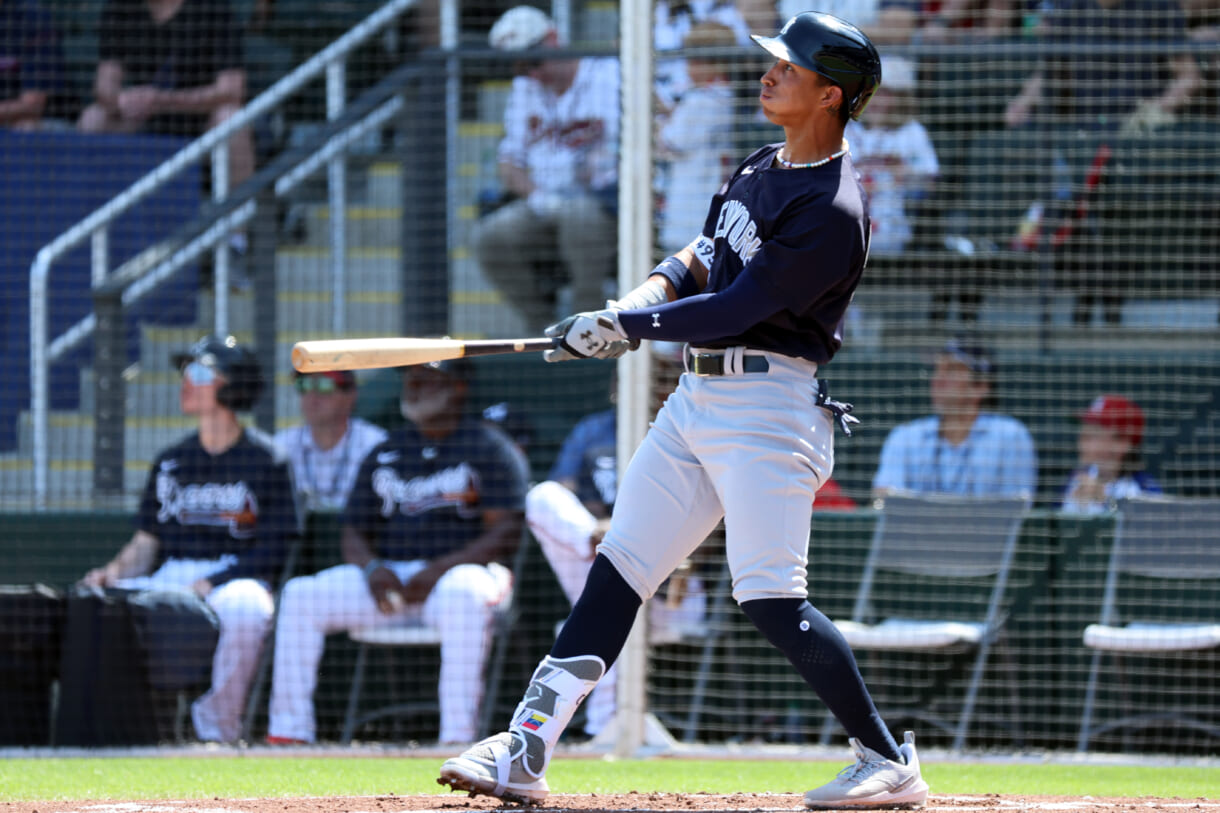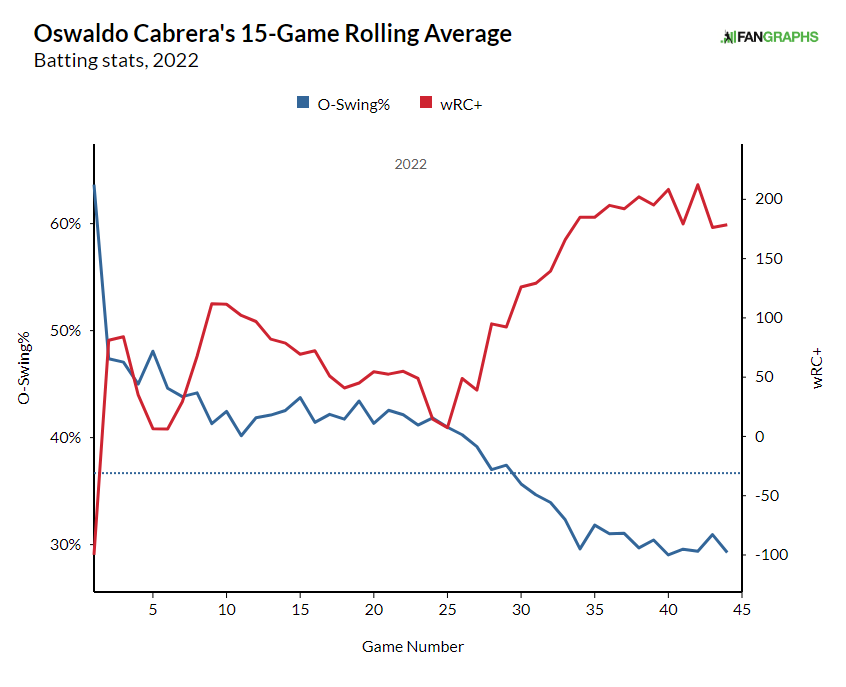
Harrison Bader’s oblique issue will cause him to go on the IL with a strain. An often-injured player, the Yankees probably anticipated that Bader would have an IL stint during the 2023 season, as they care more about having him in October than in April. Without sounding too confident, it’s just as fair (if not more) to assume that the Yankees will participate in the 2023 postseason. The Yankees will have their depth tested, and on the position player side of the ball, Oswaldo Cabrera is the first man up. The Venezuelan native electrified the Yankees in September, and now he will be tasked with stabilizing the Yankees’ lineup as the injury bug runs rampant.
- Yankees activate exciting outfield prospect off of IL, remains in Triple-A
- Yankees are ‘actively’ targeting help at 3B at the trade deadline
- The Yankees need to make a big push for this perfect infield trade target
Improving Quality of Contact
One of the biggest improvements we’ve seen Oswaldo Cabrera make is in his quality of contact, something he struggled with in 2022. Cabrera has registered exit velocities around 110 MPH at the Triple-A level, but the issues stem from his consistency. Despite finishing with a 180 wRC+ and 9.4% Barrel% over his final 22 games, Cabrera had just an 87.4 MPH average exit velocity. It’s difficult to generate high exit velocities while hitting the ball in the air consistently, and Cabrera’s 27.5% GB% suggests plenty of loft in his swing. If he could figure out how to consistently find power in his flyballs, his ability to get out in front and pull the ball could lead to 25-30 HR potential.
The Yankees love how Cabrera lifts the ball and pulls it, but if he’s able to square up the ball more, we’ll see Cabrera reach the offensive ceiling he’s capable of. So far in Spring Training, he has a 92.3 MPH Exit Velocity, which seems insignificant because it’s just Spring Training, but this is unprecedented for Cabrera. Cabrera has 20 Plate Appearances in Spring Training, but he only registered an exit velocity above 92 MPH over that large of a stretch once last year from September 30th to October 4th, and he had a 172 wRC+ over that stretch.

Cabrera posted a 111 wRC+ last season, which alongside elite defense and versatility, meant he was someone the Yankees had to get in the lineup daily. This remains the case today, even with DJ LeMahieu back in the fold with a healthy toe. Cabrera is one of the few viable left-handed options on the Major League roster, and if he can continue his excellence at the plate, the Yankees won’t be able to leave him out of the lineup. It’s a huge leap for Cabrera if he can consistently drive the ball, and he’ll certainly electrify any ballpark he plays at if he puts on in the seats.
Hitting the ball hard is deemed as an “analytical” thing, but it’s been around in the game of baseball since its inception. The Yankees are obsessed with exit velocity, but so are their top competitors, but this isn’t new information. Generating hard contact has always been a good thing, and Cabrera adding some more mileage to his batted balls should result in a higher SLG%, but also in a greater BA due to an increasing BAPIP (Batting Average on Balls in Play). Higher exit velocities result in higher hit expectancies, so it’s possible we see a better BA/OBP in 2023.
Part of what goes into OBP, however is plate discipline, which is something we’ve seen Oswaldo Cabrera take huge strides with at the Major League level.
Yankees Seeing Better Swing Decision From Cabrera
One of the fundamentals of baseball that people don’t talk about enough is your swing decisions. Swinging at strikes and laying off of balls as a concept is pretty simple to grasp, but it’s remarkably difficult to execute. Pitchers are better than they’ve ever been, and modern technology has optimized the pitch shape of arms across the game. Oswaldo Cabrera had a shoulder issue to start the year in 2022 that caused him to struggle with his strikeout rates and potentially delayed his MLB debut, but once he returned, we saw a massive improvement in his strikeout and walk totals:
- First 22 Triple-A Games (Injured)
- 8.4% BB%
- 32.6% K%
- Final 25 Triple-A Games (Post-Injury)
- 9.7% BB%
- 21.2% K%
While his walk rate didn’t see a massive improvement, the reduction in strikeouts and whiffs made Cabrera a rockstar with Scranton. He clubbed seven HRs while hitting .330 in that 25-game stint, giving him a 170 wRC+. In total, his MiLB chase rate was well above average, and his contact rates dramatically improved as the season went on. This same trend occurred at the MLB level, minus the injury-riddled start. Cabrera was pressing early on, forcing swing decisions and trying to get out in front of the baseball to pull the ball in the air, as if he could hit a home run, the Yankees could potentially pull themselves out of their slump.
Some people forget the context as to exactly how Cabrera was thrust into the lineup, with the Yankees in the midst of a slump that led to back-to-back series losses at home to the Rays and Blue Jays, who were hot on New York’s tail. He was an excellent defender, but his bat was unplayable. To further the damage, Andrew Benintendi had suffered a season-ending hamate bone injury, and with Aaron Hicks’ confidence shot, the Yankees turned to an infielder to play LF. They were on the precipice of the greatest division collapse in the modern era, but Oswaldo Cabrera rose to the occasion.
The Yankees entered that game tied 1-1 in a crucial series to gain momentum after taking three out of four against the Twins, and Cabrera landed the finishing blow on the Tampa Bay Rays’ divisional hopes. His first HR at the Major League level, it sparked a torrid stretch where he slashed .293/.384/.600 with 180 wRC+ over the rest of the season, playing all over the diamond and eventually cementing himself as the starting LF of the New York Yankees. How did Oswaldo Cabrera turn things around? Well, it all comes down to swing decisions.

O-Swing% is out-of-zone swing rate, which is the cooler way of saying “chase rate”. We can see a sharp decline in his chase rate as he continued to play, representing his maturity at the plate as he propelled the Yankees to a 15-7 finish and the AL East crown. We saw Cabrera’s BB% increase dramatically, no longer being afraid to pass the baton to the guy behind him. Rookies love to swing, and it makes sense, they’re young and get their first crack at baseball’s biggest stage, and everyone dreams of that moment.
The improvement of his plate discipline combined with shift restrictions could give Cabrera a ~.330 OBP, and when you see his .182 Isolated Power (SLG% – BA) from last season, you’re looking at a very well-rounded hitter. Cabrera embodies the jack-of-all-trades archetype, and while he doesn’t possess many elite traits, he’s above average in so many categories that it more than makes up for it. Figuring out how to stay within himself changed the direction of his season, but now the Yankees are going to need him to step up once again.
How Does Oswaldo Cabrera’s Role Change With Bader Out?
The Yankees have been adamant about wanting Oswaldo Cabrera to play all around the diamond, and while that’s still a possibility, the Yankees should certainly start Cabrera in RF as much as possible. Plenty of fans dislike Aaron Hicks, which is understandable, but the Yankees want to see if the adjustments he’s made in his hand placement can translate from Spring Training to the regular season. You may not like it, but Hicks’ defense in LF is easily the best on the roster, and if his bat can improve from his 90 wRC+ mark last season, he’s a quality starting outfielder.
In the world where he struggles similarly to how he did in the 2nd half of last year, then you may see the Yankees get creative in LF. One of the standout names for LF is Rafael Ortega, who in my eyes provides the Yankees with a high-OBP bat that can play all three outfield spots and give them left-handed power. Willie Calhoun has also impressed, but his inability to play the outfield reliably on a team with a depleted depth chart could hurt his chances of making the team. With all of that in mind, Cabrera needs to be the guy in this group that plays the most.
I can cite data until my fingers turn blue, but there’s an electrifying energy that Cabrera possesses that can bring a spark to any lineup. While Harrison Bader is the better baseball player due to his elite defense at a premier defensive position and great baserunning, the better hitter might just be Oswaldo Cabrera. By playing Hicks-Judge-Cabrera in LF-CF-RF, the Yankees remain elite defensively without taking a step back offensively. Are they worse with Bader on the IL? Absolutely, there is no way to argue otherwise. Can Oswaldo Cabrera help the Yankees flourish in Bader’s absence? 100%.
Overshadowed by the excitement around Oswald Peraza’s rookie campaign, Jasson Dominguez’s towering drives, and Anthony Volpe’s incredible maturity is the rookie who has proven the most at the Major League level so far; Oswaldo Cabrera. The Yankees are still going to rotate Cabrera around the infield, as Stanton could play RF in a pinch with Judge in CF and Ortega can also man the outfield if need be.
It sucks to lose Harrison Bader, who also has that tantalizing presence on the field with his speed and athleticism, but the Yankees have to press forward. Injuries are a constant in baseball, an adversity the Yankees are going to have to prove they can overcome. No one’s going to feel sorry for the Bronx Bombers, and they’ll turn to Oswaldo Cabrera to give opponents a real reason to feel sorry.